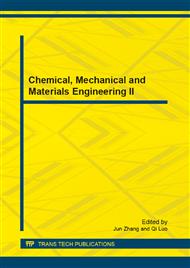[1]
Hein KRG, Bemtgen JM. EU clean coal technology—co-combustion of coal and biomass. Fuel Process Technol (1998); 54:159-169.
DOI: 10.1016/s0378-3820(97)00067-2
Google Scholar
[2]
Harding NS, Adams BR. Biomass as a reburning fuel: a specialized cofiring application. Biomass and Bioenergy (2000); 19:429-445.
DOI: 10.1016/s0961-9534(00)00054-4
Google Scholar
[3]
Hughes EE, Tillman DA. Biomass cofiring: status and prospects 1996. Fuel Processing Technology (1998); 54:127-142.
DOI: 10.1016/s0378-3820(97)00064-7
Google Scholar
[4]
Demirbaş A. Sustainable cofiring of biomass with coal. Energy Conversion and Management (2003); 44:1465-1479.
DOI: 10.1016/s0196-8904(02)00144-9
Google Scholar
[5]
Sami M, Annamalai K, Wooldridge M. Co-firing of coal and biomass fuel blends. Prog Energ Combust (2001); 27:171-214.
DOI: 10.1016/s0360-1285(00)00020-4
Google Scholar
[6]
Sahu SG, Sarkar P, Chakraborty N, Adak AK. Thermogravimetric assessment of combustion characteristics of blends of a coal with different biomass chars. Fuel Process Technol (2010); 91:369-378.
DOI: 10.1016/j.fuproc.2009.12.001
Google Scholar
[7]
Skoulou VK, Manara P, Zabaniotou AA. H2 enriched fuels from co-pyrolysis of crude glycerol with biomass. Journal of Analytical and Applied Pyrolysis (2012); 97:198-204.
DOI: 10.1016/j.jaap.2012.05.011
Google Scholar
[8]
Haykiri-Acma H, Yaman S. Interaction between biomass and different rank coals during co-pyrolysis. Renewable Energy (2010); 35:288-292.
DOI: 10.1016/j.renene.2009.08.001
Google Scholar
[9]
Vuthaluru HB. Thermal behaviour of coal/biomass blends during co-pyrolysis. Fuel Processing Technology (2004); 85:141-155.
DOI: 10.1016/s0378-3820(03)00112-7
Google Scholar
[10]
Sebastián F, Royo J, Gómez M. Cofiring versus biomass-fired power plants: GHG (Greenhouse Gases) emissions savings comparison by means of LCA (Life Cycle Assessment) methodology. Energy (2011); 36:2029-2037.
DOI: 10.1016/j.energy.2010.06.003
Google Scholar
[11]
Emami Taba L, Irfan MF, Wan Daud WAM, Chakrabarti MH. The effect of temperature on various parameters in coal, biomass and CO-gasification: A review. Renewable and Sustainable Energy Reviews (2012); 16:5584-5596.
DOI: 10.1016/j.rser.2012.06.015
Google Scholar
[12]
Kumabe K, Hanaoka T, Fujimoto S, Minowa T, Sakanishi K. Co-gasification of woody biomass and coal with air and steam. Fuel (2007); 86:684-689.
DOI: 10.1016/j.fuel.2006.08.026
Google Scholar
[13]
De S, Assadi M. Impact of cofiring biomass with coal in power plants – A techno-economic assessment. Biomass and Bioenergy (2009); 33:283-293.
DOI: 10.1016/j.biombioe.2008.07.005
Google Scholar
[14]
Sondreal EA, Benson SA, Hurley JP, Mann MD, Pavlish JH, Swanson ML, Weber GF, Zygarlicke CJ. Review of advances in combustion technology and biomass cofiring. Fuel Processing Technology (2001); 71:7-38.
DOI: 10.1016/s0378-3820(01)00134-5
Google Scholar
[15]
Tillman DA, Duong DNB, Harding NS. Chapter 4 - Blending Coal with Biomass: Cofiring Biomass with Coal. In: Solid Fuel Blending. Boston: Butterworth-Heinemann; 2012, pp.125-200.
DOI: 10.1016/b978-0-12-380932-2.00004-0
Google Scholar
[16]
Saidur R, Abdelaziz EA, Demirbas A, Hossain MS, Mekhilef S. A review on biomass as a fuel for boilers. Renewable and Sustainable Energy Reviews (2011); 15:2262-2289.
DOI: 10.1016/j.rser.2011.02.015
Google Scholar
[17]
Fernández Llorente MJ, Carrasco García JE. Comparing methods for predicting the sintering of biomass ash in combustion. Fuel (2005); 84:1893-1900.
DOI: 10.1016/j.fuel.2005.04.010
Google Scholar
[18]
Pang CH, Hewakandamby B, Wu T, Lester E. An automated ash fusion test for characterisation of the behaviour of ashes from biomass and coal at elevated temperatures. Fuel.
DOI: 10.1016/j.fuel.2012.06.120
Google Scholar


